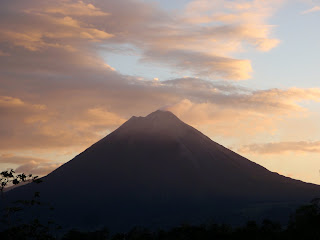It was a dark and stormy night when we finally reached our hotel, Leaves & Lizards, overlooking Costa Rica’s Arenal Volcano. It had taken nine long, hard hours to get there from Samara.
The owners of Leaves & Lizards also ran a farm across the road. After we looked around the hotel, we headed toward the barn. It had nine horses and about fifty chickens and four turkeys. I was most interested in a cement stall in which stood a pregnant piece of bacon. Well, it was not bacon yet but if my dad had a knife we would have had a nice breakfast. The pig was as big as a full-size refrigerator. I didn’t want to go in the stall because I was afraid of getting crushed to death.
The owner, Debbie, said that the pig might have its babies that night. She promised that she would wake us up if that happened. The next day, though, the pig still had not given birth. So, we set off to do chores with the caretaker, Carlos. We collected the eggs, and fed and brushed the horses. We could not milk the cow because it was away getting bred with a bull.
Every time we returned from a hike or a trip, we would look in and see if the pig had had her piglets. Four days went by without any piglets, but on the fifth day she had them. Thirteen little piglets, three girls and ten boys. They were brown, pink, pink with black spots, and brown with black spots. When you picked one up, it would scream like crazy. They sounded like human babies. I thought they were adorable.
I sat in the stall with the piglets for hours watching them. They would fight over milk and get squashed by each other. They fell asleep drinking milk. My favorite piglet was the first born. He was pinkish-white and the size of both my hands. He was one of the weakest, probably a runt. He would try to get milk but he wasn’t tall enough to reach it, so he would go to the bottom and get squashed.
Debbie said that the strongest piglets would go in a different pen after six weeks, and the runts would stay for a couple more weeks with their mom.
On the last day my brother and I got to milk a cow. Milking the cow felt really cool because the udders were like jets. When you squeezed a teat, the milk would shoot everywhere. We got 2 gallons of milk. Debbie and her husband Steve will make cheese, butter, and buttermilk with it.

Miss Piggy,um, where's Kermit?

Jamón, Proscuitto, Serrano, Cappacola, Chorizo, Smithfield...

I'm calling him Bacon!

Boston Butt?

Udderly fascinating.


